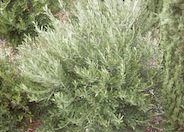
Common name:Gray Lavender Cotton
Botanical name:Santolina chamaecyparissus
This ground cover/small shrub will grow to 3' tall and has small, grayish silver leaves with yellow flowers that bloom in the summer.

Common name:Little Ollie Dwarf Olive
Botanical name:Olea europaea 'Little Ollie'
This evergreen shrub will grow to 8' tall and wide. It doesn't produce any fruit. It will do well in hot dry areas but can also survive in coastal areas. It has a compact round habit making it great for borders. It can be used for bonsai. It prefers well draining soil and is drought tolerant once it's established.

Common name:Spineless Yucca
Botanical name:Yucca recurvifolia
This evergreen shrub is part of the Agave family and reaches 6'-10' tall. It has distinctive blue gray leaves that bend sharply downward. It blooms with white flowers on 3'-5' tall spikes in late spring and early summer. Leaf tips have spines but they bend and do not cause injury.

Common name:Spanish Lavender
Botanical name:Lavandula stoechas
This dense shrub grows 2'-3' tall with blue gray foliage and deep purple flowers that have large showy bracts near the top of the spikes. It is drought tolerant . - Cornflower Farms

Common name:Coast Live Oak
Botanical name:Quercus agrifolia
The Coast Live Oak is an evergreen round headed tree. It can reach 15'-40' high and 20' wide; it grows very well from the coastal areas to the interior valleys. It is native to California, is drought tolerant, and attracts butterflies. -Cornflower Farms
The Magic of Mulch
In the natural world the endless cycle of birth, growth, decay, death and rebirth flows throughout the seasons. Plants die, leaves fall and new growth springs up in its place. Nothing is lost and the fallen leaves and dead plants decay into the soil, enriching it for the next generation of growth.
Click in the green box for more information
| Designer: Los Angeles Arboretum | LA Arboretum 8 |
Photographer: GardenSoft |
Soils and Compost:
Practice grass-cycling by leaving short grass clippings on lawns after mowing, so that nutrients and organic matter are returned to the soil.
Water Saving Tip:
Be sure to fix all leaks promptly no matter how small they may seem.
Integrated Pest Management:
Drip and other smart irrigation delivers water directly to roots, allowing no excess water for weeds.
